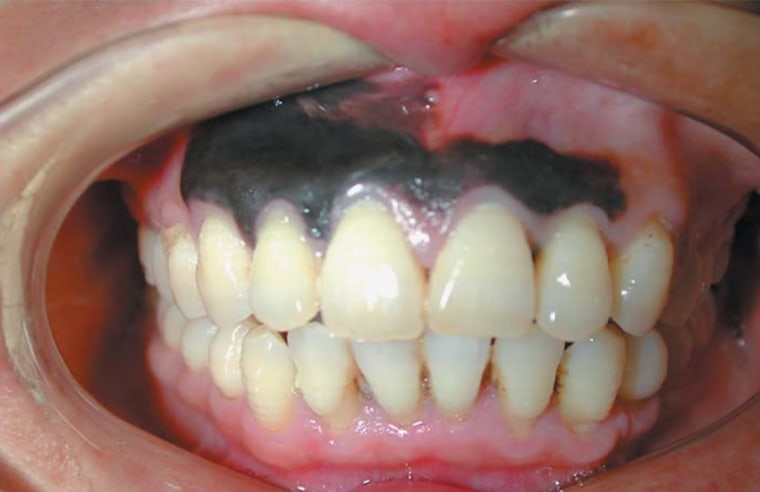A 45-year-old man in China who developed a large, dark discoloration of his upper gums had a rare type of melanoma, a cancer that usually happens on the skin, according to a new report of his case.
"This is an unbelievably rare type of melanoma," said Dr. Susan Muller, professor of head and neck surgery at Emory University, who wasn't involved with the case.
This type of melanoma, medically known as mucosal melanoma, constitutes less than 1 percent of all melanoma cases, Muller said.
The area of the man's gums that was darkly pigmented measured about 0.5 inches wide by 1.5 inches long. When a biopsy showed the dark lesion was, indeed, cancerous, doctors removed not only the gums but also parts of the man's upper jaw, according to the case report, published Wednesday in The New England Journal of Medicine.
Melanoma is cancer of melanocytes, cells that produce the pigments that color the skin. It is the least common type of skin cancer, but one of the most dangerous if it's not caught early. Melanocyte cells exist in some other parts of the body, too — for example, in the eyes, sinuses and mouth — but their function in these places is not clear.
"At this point, we don't know, first, why there are melanocytes in the mouth, and second, what makes those cells go bad and become malignant," Muller told LiveScience.
Muller and her colleagues previously looked at people with melanomas in the head and neck region who were treated at Emory University and affiliated hospitals. Over a 20-year period, they found 22 people who had melanoma in the sinuses, and only eight people who had melanoma in the mouth. Their study was published in the journal Oral Oncology in 2008.
Similar to the man in the new case report, in every instance of oral melanoma in Muller's study, the cancer grew in the patient's upper jaw and roof of the mouth. "We have no idea why that happens," Muller said.
In the man's case, when doctors followed up with him six months after his surgery, they found no signs that the cancer had come back.

Pigmentation in the mouth is not uncommon, and can be caused by many things, Muller noted. Although dark spots in the mouth might look like melanoma, they are usually benign. However, nothing other than melanoma would look like the black, large, diffuse pigmentation seen in this patient, Muller said.
Treating melanomas that occur in the head and neck region can be challenging. When removing any tumor, doctors like to have "clear margins" — meaning they have removed a big enough area of tissue around the cancer to lower the chance that cancer cells remain in the body. This can be problematic when the cancer is in the head and neck area, Muller said.
Related: 13 oddest medical case reports
"If you have cancer in the liver, they can remove the liver — but if you have cancer in the head, you can't remove the head," Muller said. What's more, melanomas in the head and neck region are not as responsive to the chemotherapy used for melanomas of the skin.
Another challenge in treating some cases is that the melanoma might be hidden from sight. When that happens in the sinuses, it can be hard to notice. However, melanoma in the mouth can be detected early, by dentists or patients, Muller said.
Should people examine their mouth, along with their skin, for early signs of melanoma?
"No, there's enough to worry about — the risk of oral cancer is much higher," Muller said. "This case is a good reminder that melanoma could happen in the oral cavity, but it's a very rare event."
Email Bahar Gholipour or follow her@alterwired. Follow LiveScience @livescience, Facebook & Google+. Original article on LiveScience.
Related content